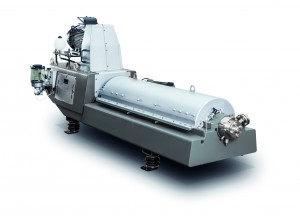Unique possibilities and new potentials through applying decanters in the brewhouse
Mash separation in the brewing process with GEA Westfalia Separator  ecoforce gMaster
ecoforce gMaster
In the beverage industry, the reliable separation of solids is one of the critical points in beverage production. The separation selectivity must fulfil high requirements and offer the option of automatic cleaning. GEA Westfalia Separator Group satisfies the requirements of numerous applications in the beer, wine and fruit juice producing sectors with the decanters from the ecoforce gMaster family.
The gMaster is setting new standards in terms of performance, easy cleaning, highest product quality and gentle processing. The high-speed decanter generates maximum centrifugal acceleration
(g-forces) which ensures optimum separation in a broad spectrum of applications. A special focus during the design and production process was put on the hygienic design of the machines.
Process application in the brewhouse
Lauter tuns (for coarse grits) and mash filters (for fine grits) were previously accepted state-of-the-art in the brewhouse. Both processes are based on filtration and require the formation of a filtration cake. Problems arise when using raw materials without a filter-forming husk layer.
Decanters have been familiar in the brewing industry since 1980. GEA Brewery Systems has developed and optimized a process for the new gMaster decanter generation in collaboration with GEA Westfalia Separator Group. Through separating the spent grain fraction in the centrifugal field, low-husk and husk-free brewing materials can be processed without difficulty. Thanks to the further development of the liquid flow management in the machine, oxygen intake during mash separation is consistently avoided. Given optimum process management, first wort yields of over 90 percent can be achieved. With the gMaster machines, a continuously operating lautering equipment is now available which can be integrated in a brewhouse in different configurations. The desired yields can be realized when using the machine in a two-stage process with a first wort step and a sparging step.
The energy-optimized brewhouse 2.0 can consequently be developed to a continuously operating brewhouse. The use of, for example, sorghum, rice, corn and cassava also enables the production of traditional African beers and new products in industrial plants. In addition, it is also possible to install an “adjunct line” in conventional brewhouses in parallel to the existing 100-% malt operation. This provides maximum flexibility in terms of the raw material used while opening up new markets simultaneously and providing the opportunity of launching new products on the fiercely competitive beverage market. This applies especially to the growth markets in Asia and Africa.
High-torque drive for more energy efficiency
For many years, the beverage industry has been characterized by pressure for innovation and constant development – here too, the gMaster offers the answer. They can be configured precisely for individual customer requirements and applications and moreover offers economic advantages due to low operating costs: the high-torque summationdrive reliably provides the optimum differential speed for the process, guaranteeing the best possible mode of operation. Here, only the power actually required is fed into the motors, so the drive works extremely energy-efficiently.
If customers opt for the gMaster, a comprehensive service package is available to them with the product solutions of serv&care and the process solutions from Servicenext level, guaranteeing maximum availability with complete budget security.

































